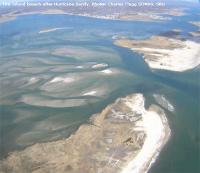Reducing the wrath of Hurricane Sandy
In the United States, thousands of miles of coastal national parks and wildlife refuges, made up of beaches, dunes and wetlands, provide natural storm protection for coastal communities.
This 'natural service' is proving all the more important as climate change increases the intensity of storms and hurricanes, graphically illustrated by the impact of Hurricane Sandy which, in 2012, wreaked havoc along the east coast of the US.
Fire Island National Seashore, a coastal barrier island, has provided a natural defence to the communities of the south shore of Long Island, New York, for hundreds of years. The 17 largely summer communities that are now located within the park, routinely suffer substantial damage from coastal storms.
Unlike many of the hardest-hit areas, Fire Island had a robust system of dunes, ranging from 10 to 20 feet in height, that largely absorbed the ocean's force.
The force of the wind and storm surge caused numerous overwashes and resulted in three breaches – where water flows freely between the ocean and the bay. Half of the dunes along the Fire Island barrier were affected, losing about 60% of their volume.
Of the three breaches within the Seashore, one closed naturally, and another, within the Smith Point County Park, was closed manually weeks after the storm. The third, within the Otis Pike federal wilderness area, remains open.
There are few examples where a breach in a barrier island that provides storm protection along a densely populated coastline has deliberately been allowed to remain open to benefit the environment.
Breaching is a natural process that is important for the long-term sustainability of the coastal barrier system. It builds up the width of the barrier, helps landward migration of the barrier under rising sea level, promotes the development of diverse habitats such as saltmarshes and inter-tidal flats and increases water quality of back-bay ecosystems.
The ecological and physical response to the wilderness breach is being extensively monitored by National Park Service ecologists, US Geological Survey scientists and others. The findings will be important in evaluating future scenarios of sea-level rise. Recent studies show that much of the developed US coastline is vulnerable to future sea-level rise. This, together with projected increased storm intensity, means coastal barrier islands will be increasingly vulnerable, affecting their protection potential.







